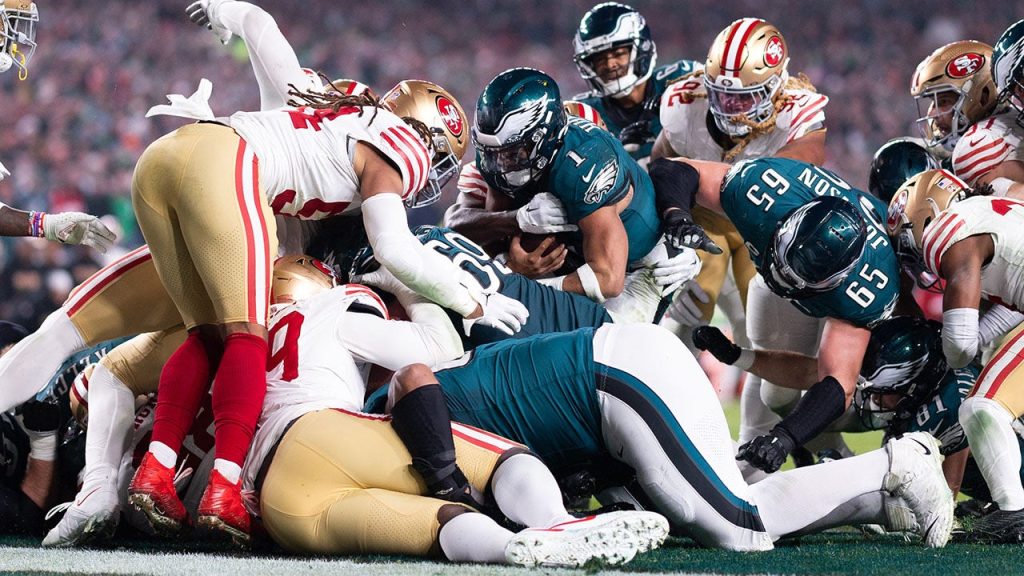The Philadelphia Eagles’ innovative “tush push” play, a quarterback sneak variant that involves pushing Jalen Hurts across the line of scrimmage, has become a focal point of their offensive strategy and a source of both admiration and controversy in the NFL. Its remarkable success rate, particularly in short-yardage situations, played a crucial role in the Eagles’ Super Bowl run two years ago and has once again propelled them to the championship game in Super Bowl LIX. While fans and analysts have embraced the catchy moniker “tush push,” Hurts himself prefers the more traditional term “quarterback sneak,” downplaying the hype surrounding the play. This understated approach reflects Hurts’ focus on execution rather than the surrounding fanfare.
The “tush push” involves a coordinated effort by the offensive line to push Hurts forward, often with multiple players contributing to the shove. This tactic effectively overcomes the defensive line’s resistance, allowing Hurts to gain the necessary yardage for a first down or even a touchdown. The play’s high success rate – it was stopped only four times during the 2023 season – has led to debates about its legality and fairness within the NFL. Some argue that it provides an unfair advantage, while others view it as a legitimate strategic innovation. This controversy, coupled with the play’s visual distinctiveness, has thrust the “tush push” into the spotlight, making it a topic of much discussion leading up to Super Bowl LIX.
The debate surrounding the “tush push” intensified following the 2023 season, with some voices advocating for its banishment from the NFL rulebook. The play’s effectiveness, particularly in crucial game situations, raised concerns about its potential to disrupt the competitive balance of the league. However, NFL executive Troy Vincent countered these arguments, asserting that banning the play would be unfair to teams that have successfully integrated it into their offensive schemes. Vincent’s stance underscored the league’s recognition of strategic innovation and its reluctance to penalize teams for effectively utilizing legal tactics. This stance effectively preserved the “tush push” as a viable play, setting the stage for its continued use in high-stakes games like the Super Bowl.
The “tush push” proved particularly problematic for the Washington Commanders during the NFC Championship game. The Commanders’ inability to stop the play, coupled with their repeated offsides penalties, nearly resulted in the referees awarding Philadelphia a score. This highlighted the difficulty of defending against the “tush push” and the potential for defensive miscues to exacerbate its effectiveness. The Commanders’ struggles serve as a cautionary tale for the Kansas City Chiefs, who will need to devise a robust defensive strategy to counter the play in Super Bowl LIX. Their ability to contain the “tush push” could be a key factor in determining the outcome of the championship game.
The Kansas City Chiefs’ defensive game plan will undoubtedly focus on neutralizing the “tush push,” recognizing its potential to disrupt their defensive efforts. Stopping the play requires a combination of disciplined play, strategic alignment, and sheer physical strength. The Chiefs’ defensive line will need to anticipate the snap count and avoid being caught offsides, while simultaneously generating enough force to counteract the Eagles’ coordinated push. This challenge underscores the strategic complexity of the “tush push” and its impact on both offensive and defensive game planning.
The “tush push,” despite its unassuming name and the controversy surrounding it, represents a significant development in NFL offensive strategy. Its effectiveness in short-yardage situations has provided the Philadelphia Eagles with a valuable tool for extending drives and scoring touchdowns. Whether one calls it the “tush push,” the “brotherly shove,” or simply a quarterback sneak, the play’s impact is undeniable. Its prominence in the Eagles’ offensive arsenal and the challenges it poses to opposing defenses make it a compelling storyline heading into Super Bowl LIX. The game will serve as a showcase for the play’s effectiveness and its potential to influence future offensive strategies in the NFL.

